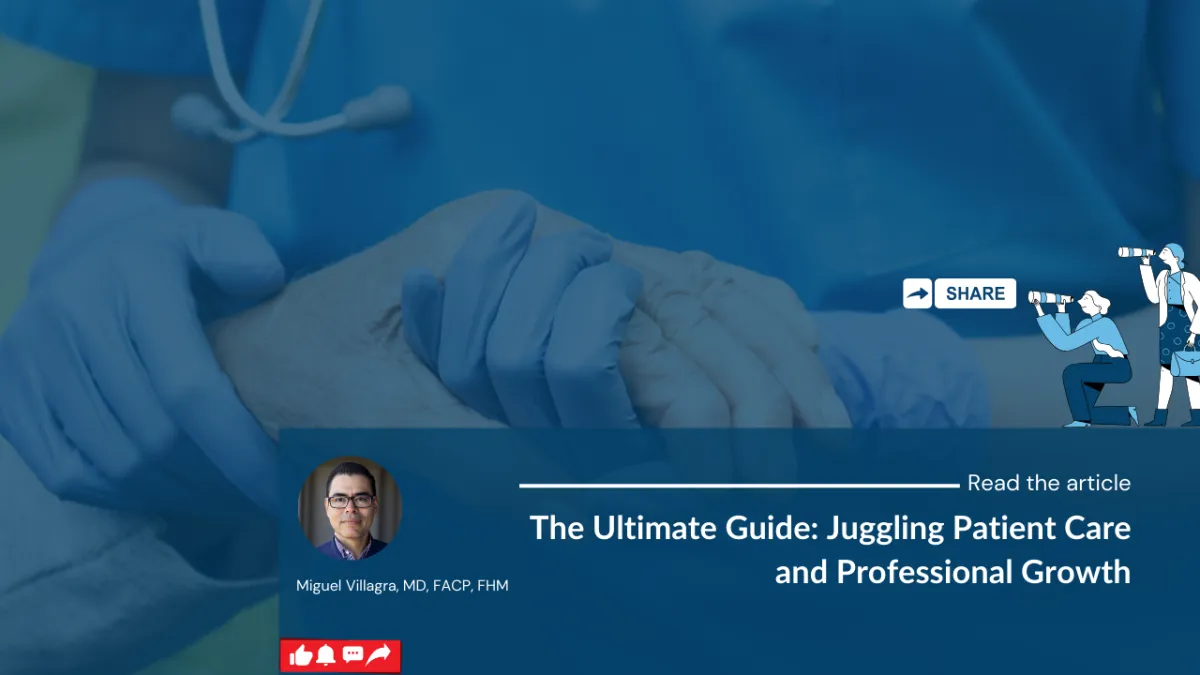
The Ultimate Guide: Juggling Patient Care and Professional Growth
Pursuing further education while maintaining a clinical workload is a rewarding endeavor, but it comes with unique challenges. Whether you’re earning an advanced degree, obtaining a new certification, or completing specialized training, the ability to balance your studies with your career and personal life is essential to your success.

This guide offers practical strategies to help healthcare professionals navigate the demands of education and practice while achieving their personal and professional goals.
Why Furthering Your Education Matters
Invest in Yourself and Your Career

In the fast-evolving healthcare industry, continuous education is critical. It keeps you updated on best practices, opens doors to new opportunities, and allows you to better serve your patients.
Key Benefits of Continuing Education:
Career Advancement: Gain qualifications for leadership roles, specialization, or non-clinical opportunities.
Improved Patient Care: Enhance your knowledge to provide higher-quality, evidence-based care.
Personal Fulfillment: Achieving educational milestones can reignite your passion for healthcare and professional growth.
However, balancing education with a demanding healthcare role requires careful planning and perseverance.
Understanding this balance is crucial for success in both domains. Let's explore practical strategies that can help you excel in your studies while maintaining high standards of patient care. These proven approaches have helped countless healthcare professionals achieve their educational goals without compromising their clinical responsibilities.
Step 1: Prioritize Time Management
The Key to Balance
Effective time management is the foundation of balancing work, education, and personal life.

Tips for Managing Your Time:
Create a Structured Schedule: Use digital calendars or planners to block out time for work shifts, study sessions, and personal commitments.
Set Daily Priorities: Identify your top three tasks each day to ensure you stay focused on what matters most.
Plan Ahead: Review your syllabus and work schedule to anticipate busy periods and plan accordingly.
Avoid Over commitment: Learn to say no to unnecessary obligations to protect your time and energy.
Example:
A nurse practitioner earning a DNP might schedule morning study sessions on days off and use evenings to review lecture recordings or complete assignments.
Pro Tip: Batch similar tasks together, such as dedicating one evening per week to academic discussions or group projects, to increase efficiency.
The key is to find a rhythm that works for you and stick to it. Creating a consistent routine helps your brain adapt to dedicated study times, making it easier to focus and retain information. Remember that flexibility within your structured schedule allows you to adapt to unexpected changes while maintaining productivity.
Step 2: Choose Flexible Educational Programs
Find the Right Fit for Your Life
Healthcare professionals often juggle unpredictable schedules, making flexibility a crucial factor when selecting educational programs.

What to Look For in a Program:
Part-Time or Online Options: Programs that allow you to learn at your own pace or attend virtual classes accommodate a busy schedule.
Hybrid Models: Combine in-person and online coursework for hands-on learning without full-time commitment.
Career Alignment: Ensure the program’s curriculum matches your long-term goals, whether it’s leadership, clinical specialization, or non-clinical roles.
Example:
A physical therapist pursuing a certification in telehealth might enroll in an online course with asynchronous modules, allowing them to complete lessons during weekends or after shifts.
Pro Tip: Reach out to alumni of prospective programs to gain insight into how they balanced education with work.
Additionally, consider scheduling informational interviews with professionals who successfully balanced similar educational pursuits. Their firsthand experiences can provide valuable insights into managing workload, avoiding common pitfalls, and maximizing learning opportunities while maintaining clinical responsibilities.
Step 3: Communicate with Employers and Peers
Build a Support System
Transparency and collaboration with your workplace and colleagues can help you create a supportive environment for your dual responsibilities.

How to Gain Support:
Speak with Your Employer: Share your educational goals and discuss potential accommodations, such as adjusted schedules, reduced hours, or tuition reimbursement programs.
Lean on Mentors: Seek guidance from colleagues or mentors who have balanced similar challenges. Their advice and encouragement can be invaluable.
Collaborate with Peers: Join study groups or connect with others in similar programs for accountability and motivation.
Example:
A physician assistant enrolled in an MPH program might work with their manager to schedule shifts around key academic deadlines, ensuring adequate time for assignments and exams.
Pro Tip: Approach conversations with employers prepared with a clear plan that outlines how you’ll manage your responsibilities while pursuing education.
Remember that open communication is a two-way street. Keep your employer updated on your academic progress and any challenges you encounter, and be receptive to their feedback and suggestions. This collaborative approach helps maintain trust and ensures mutual understanding of expectations.
Step 4: Maximize Your Downtime
Work Smarter, Not Harder
Healthcare providers often have limited free time, so using it wisely can make a significant difference.

How to Make the Most of Your Time:
Leverage Commute Time: Listen to recorded lectures, podcasts, or audiobooks related to your coursework.
Use Short Breaks: Review flashcards, read key articles, or outline assignments during downtime between shifts.
Integrate Learning with Practice: Apply concepts from your studies directly to your clinical work, reinforcing your knowledge while benefiting your patients.
Example:
A nurse studying for an advanced certification might review practice questions during lunch breaks or use case studies from their clinical practice to inform assignments.
Pro Tip: Identify your peak productivity times—morning, afternoon, or evening—and schedule your most challenging tasks during those periods.
The key is to be strategic about your energy levels and cognitive demands. For example, if you're most alert in the morning, tackle complex coursework before your shift starts. This approach ensures you're maximizing your natural rhythms while maintaining quality in both your studies and patient care.
Step 5: Set Realistic Goals and Celebrate Progress
Stay Motivated and Avoid Burnout
Balancing education and work is a marathon, not a sprint. Setting achievable goals and recognizing milestones along the way can help you stay motivated.

How to Stay on Track:
Break Down Milestones: Divide your academic journey into smaller, manageable steps, such as completing one course or earning a specific grade.
Celebrate Wins: Acknowledge achievements, whether it’s acing an exam, finishing a project, or successfully balancing a tough week.
Monitor Your Well-Being: Regularly check in with yourself to ensure you’re not overextending. Adjust your schedule or seek additional support if needed.
Example:
A pharmacist pursuing an MBA might reward themselves with a weekend getaway after completing a particularly demanding semester.
Pro Tip: Remember that self-care isn’t optional—schedule time for relaxation, exercise, and social connections to maintain balance.
Setting realistic expectations and boundaries is crucial. Remember that both your education and patient care require your best self, so maintaining balance isn't just beneficial—it's essential for long-term success. When you prioritize self-care and sustainable practices, you're better equipped to handle the dual demands of learning and healing.
Overcoming Common Challenges
You’re Not Alone in This Journey
Balancing healthcare practice and education comes with challenges, but they can be managed with the right mindset and strategies.

Challenges and Solutions:
Time Constraints: Prioritize and delegate tasks when possible. Focus on what’s essential and let go of perfectionism.
Fatigue: Incorporate short breaks and prioritize sleep to maintain energy and focus.
Feeling Overwhelmed: Break tasks into smaller steps and seek support from mentors, peers, or a career coach.
Pro Tip: Keep a visual reminder of your goals—such as a vision board or a note with your “why”—to stay motivated during tough times.
Remember that setbacks are normal and part of the learning process. What matters most is your resilience and commitment to growth. When challenges arise, refer back to these strategies and lean on your support system for guidance and encouragement.
Conclusion: The Balance is Worth It
Balancing education and healthcare practice is no small feat, but the rewards—both personal and professional—make it worthwhile. With effective time management, flexible program choices, strong communication, and a focus on self-care, you can achieve your goals without sacrificing your commitment to patient care.
Ready to Balance Education and Practice with Confidence?
At A Doctor’s Journey, we specialize in helping healthcare professionals navigate the challenges of balancing work, education, and life. Our personalized coaching programs provide the tools and support you need to succeed in advancing your career.

Take the first step toward your next milestone. Schedule a free consultation today.
Schedule Your Free Consultation
Key Takeaways
Continuous education is essential for career advancement and improved patient care in healthcare
Effective time management and structured scheduling are fundamental to balancing work and studies
Choose flexible educational programs that accommodate healthcare work schedules
Build a strong support system through open communication with employers and peers
Maximize downtime by integrating learning opportunities into daily routines
Set realistic goals, celebrate progress, and maintain work-life balance to prevent burnout
